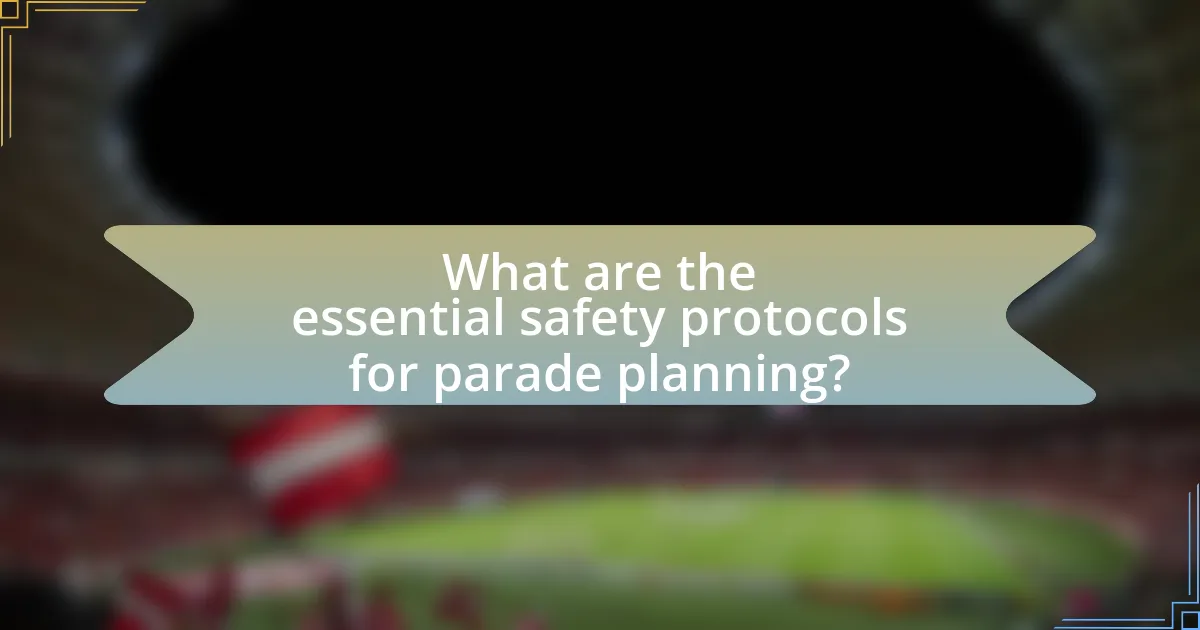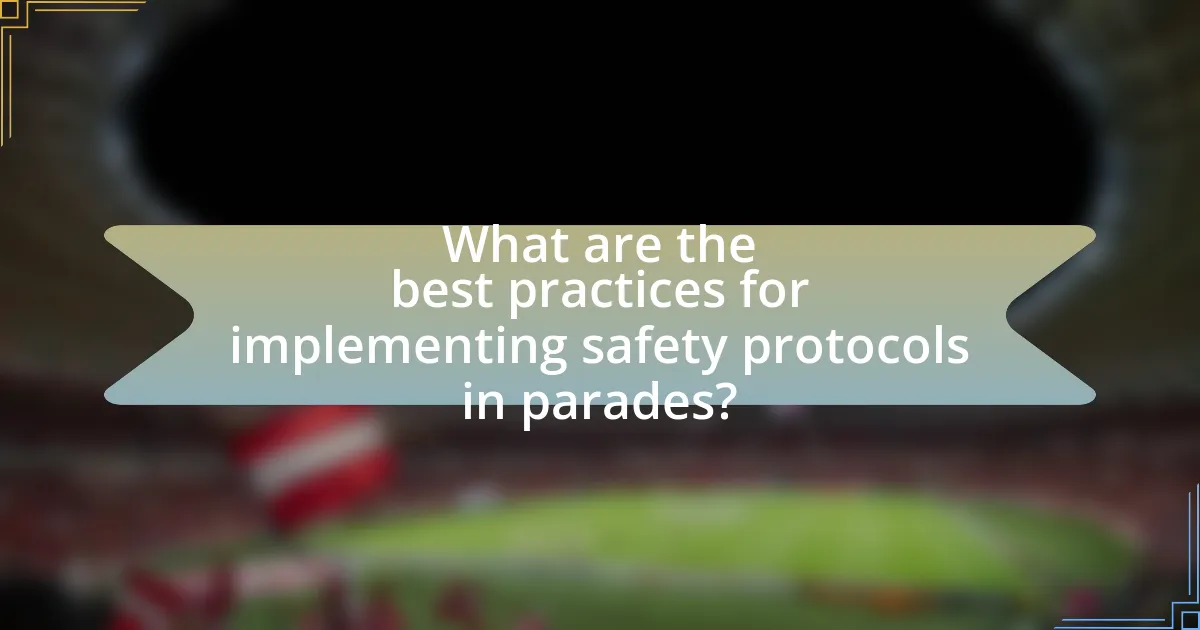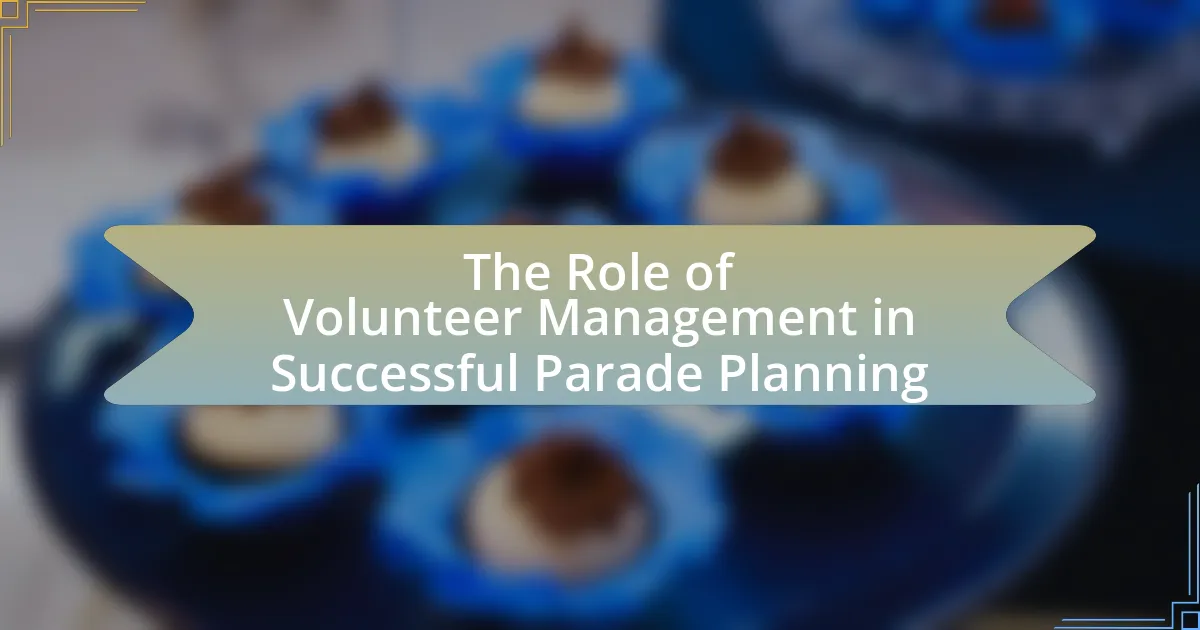The article focuses on essential safety protocols that parade planners must consider to ensure the safety of participants and spectators. Key topics include risk assessment, crowd management, emergency response planning, and effective communication strategies. It highlights the importance of local authorities in enforcing safety regulations and the need for comprehensive training for staff and volunteers. Additionally, the article discusses specific safety measures for different types of parades, the unique challenges posed by large events, and best practices for implementing safety protocols, ultimately emphasizing the critical role of preparedness in minimizing risks during public gatherings.

What are the essential safety protocols for parade planning?
The essential safety protocols for parade planning include risk assessment, crowd management, emergency response planning, and communication strategies. Risk assessment involves identifying potential hazards such as weather conditions, traffic, and crowd density, which helps in formulating appropriate safety measures. Crowd management ensures the safe flow of participants and spectators, often utilizing barriers and designated pathways to prevent overcrowding. Emergency response planning outlines procedures for medical emergencies, evacuations, and coordination with local law enforcement and emergency services. Communication strategies involve clear signage, announcements, and coordination among staff to ensure that all participants and attendees are informed of safety protocols. These protocols are critical for minimizing risks and ensuring a safe environment during the event.
Why is safety a priority in parade planning?
Safety is a priority in parade planning to protect participants and spectators from potential hazards. Parades often involve large crowds, moving vehicles, and various activities that can pose risks, such as accidents or emergencies. For instance, the National Safety Council emphasizes that crowd control measures and emergency response plans are essential to mitigate risks during large public events. Additionally, historical incidents, such as the 2017 New York City Halloween parade where a vehicle attack occurred, highlight the critical need for robust safety protocols to prevent tragedies and ensure a secure environment for all involved.
What risks are associated with parades?
Parades are associated with several risks, including crowd control issues, potential for accidents, and security threats. Crowd control can lead to injuries if attendees become unruly or if there is insufficient space for the number of participants and spectators, as evidenced by incidents like the 2017 New Year’s Eve parade in New York City, where barriers were overwhelmed. Accidents may occur due to floats, vehicles, or equipment, which can result in serious injuries; for instance, the 2014 Macy’s Thanksgiving Day Parade saw a float collide with a lamppost, injuring a spectator. Additionally, security threats, such as terrorism or violent acts, pose significant risks, highlighted by the 2013 Boston Marathon bombing, which underscores the need for thorough security planning at public events.
How can safety protocols mitigate these risks?
Safety protocols can mitigate risks by establishing clear guidelines and procedures that enhance crowd management, emergency response, and overall safety during events. For instance, implementing crowd control measures, such as designated entry and exit points, can reduce the likelihood of overcrowding and potential injuries. Additionally, training staff and volunteers in emergency response protocols ensures that they are prepared to act swiftly in case of incidents, thereby minimizing harm. Research indicates that events with well-defined safety protocols experience significantly lower rates of accidents and injuries, as evidenced by a study published in the Journal of Safety Research, which found that organized events with comprehensive safety plans reduced incidents by up to 30%.
What are the key components of a safety plan for parades?
The key components of a safety plan for parades include risk assessment, crowd management, emergency response protocols, communication strategies, and coordination with local authorities. Risk assessment identifies potential hazards such as traffic, weather, and crowd density, allowing planners to mitigate these risks effectively. Crowd management involves strategies to control the flow of participants and spectators, ensuring safe distances and preventing overcrowding. Emergency response protocols outline procedures for medical emergencies, evacuations, and other incidents, ensuring quick and organized reactions. Communication strategies facilitate clear information dissemination among organizers, participants, and emergency services, enhancing overall safety. Coordination with local authorities ensures compliance with regulations and access to necessary resources, such as police and medical support, which is critical for a successful and safe event.
What roles do local authorities play in ensuring safety?
Local authorities play a crucial role in ensuring safety by implementing regulations, coordinating emergency services, and conducting risk assessments. They establish safety standards and guidelines that event organizers must follow, ensuring compliance with local laws. For instance, local authorities often require permits for public events, which include safety plans that address crowd control, emergency access, and medical services. Additionally, they collaborate with police, fire departments, and health services to create a comprehensive safety strategy, as seen in large-scale events where multiple agencies work together to manage potential risks effectively. This coordinated approach is essential for minimizing hazards and ensuring public safety during events.
How should emergency services be integrated into the safety plan?
Emergency services should be integrated into the safety plan by establishing clear communication protocols and coordination strategies. This integration ensures that emergency responders are aware of the event layout, potential hazards, and specific roles during emergencies. For instance, conducting joint training exercises with emergency services can enhance preparedness and response efficiency, as evidenced by studies showing that coordinated efforts reduce response times by up to 30%. Additionally, including emergency service representatives in planning meetings allows for tailored safety measures that align with local resources and capabilities, thereby improving overall safety outcomes during events.
What types of safety measures should be implemented?
Parade planners should implement crowd control measures, emergency response plans, and health safety protocols. Crowd control measures include barriers and designated entry and exit points to manage the flow of attendees, which can prevent overcrowding and ensure safe movement. Emergency response plans must outline procedures for medical emergencies, evacuations, and communication with local authorities, ensuring quick and effective action during incidents. Health safety protocols should include sanitation stations and guidelines for social distancing, especially in light of public health concerns, to minimize the risk of disease transmission. These measures are essential for ensuring the safety and well-being of all participants and spectators during parades.
How can crowd control be effectively managed?
Effective crowd control can be managed through strategic planning, clear communication, and the use of trained personnel. Strategic planning involves assessing the venue, estimating crowd size, and identifying potential risks, which allows for the development of a comprehensive crowd management plan. Clear communication ensures that attendees are informed about safety protocols and emergency procedures, which can reduce panic and confusion. The deployment of trained personnel, such as security staff and volunteers, is crucial for monitoring crowd behavior and responding to incidents promptly. Research indicates that events with well-defined crowd control measures experience fewer safety incidents, highlighting the importance of these strategies in maintaining order and safety during large gatherings.
What are the best practices for managing parade floats and vehicles?
The best practices for managing parade floats and vehicles include thorough pre-parade inspections, clear communication among participants, and adherence to safety regulations. Conducting pre-parade inspections ensures that all floats and vehicles are mechanically sound and meet safety standards, reducing the risk of breakdowns or accidents during the event. Clear communication among participants, including drivers and float operators, is essential for coordinating movements and ensuring everyone is aware of their roles and responsibilities. Adhering to safety regulations, such as weight limits and fire safety protocols, further enhances the safety of the parade, as evidenced by the National Safety Council’s guidelines, which emphasize the importance of compliance to prevent incidents.
How can parade planners ensure compliance with safety regulations?
Parade planners can ensure compliance with safety regulations by conducting thorough risk assessments and adhering to local laws and guidelines. This involves identifying potential hazards, evaluating risks, and implementing appropriate safety measures, such as crowd control, emergency response plans, and proper signage. For instance, the National Fire Protection Association (NFPA) outlines specific safety standards that events must follow, which can serve as a framework for planners. Additionally, collaborating with local authorities, such as police and fire departments, can provide valuable insights and resources to enhance safety compliance.
What local laws and regulations must be considered?
Local laws and regulations that must be considered include permits, public safety ordinances, and noise regulations. Parade planners are required to obtain permits from local authorities, which often involve submitting detailed plans for the event, including route, timing, and expected attendance. Public safety ordinances dictate measures for crowd control, emergency access, and the presence of law enforcement or medical personnel. Additionally, noise regulations may limit sound levels during the event, especially in residential areas, to ensure community compliance. Compliance with these laws is essential to avoid fines and ensure the safety of participants and spectators.
How can planners stay updated on safety requirements?
Planners can stay updated on safety requirements by regularly consulting official guidelines from local government agencies and industry organizations. These entities, such as the Occupational Safety and Health Administration (OSHA) and the National Fire Protection Association (NFPA), provide current regulations and best practices that are essential for event safety. Additionally, attending workshops, webinars, and conferences focused on safety in event planning can enhance knowledge and awareness of evolving safety standards. Engaging with professional networks and forums also allows planners to share insights and updates regarding safety protocols, ensuring they remain informed about the latest developments in the field.

What specific safety protocols should be considered for different types of parades?
Different types of parades require specific safety protocols to ensure the safety of participants and spectators. For large-scale parades, such as those celebrating national holidays, crowd control measures, including barriers and designated viewing areas, are essential to manage large crowds and prevent accidents. For parades featuring vehicles, such as floats or marching bands, protocols must include vehicle inspections, driver training, and clear communication of routes to avoid collisions. In community parades, where local participants may include children and animals, protocols should emphasize supervision, first aid stations, and emergency response plans to address potential injuries. Additionally, all parades should have a comprehensive emergency plan that includes coordination with local law enforcement and medical services to respond effectively to any incidents. These protocols are supported by data indicating that organized safety measures significantly reduce the risk of accidents and injuries during public events.
How do safety protocols differ between large and small parades?
Safety protocols for large parades differ significantly from those for small parades primarily due to the scale and complexity of crowd management. Large parades typically require extensive planning, including coordination with local law enforcement, emergency services, and crowd control measures, such as barriers and designated evacuation routes. For instance, large events may implement a multi-tiered security approach, including bag checks and surveillance systems, to ensure safety for thousands of attendees. In contrast, small parades often rely on simpler measures, such as volunteer marshals and basic first aid stations, due to fewer participants and a more manageable environment. This difference in scale necessitates varying levels of resource allocation and logistical planning, as evidenced by the fact that large parades, like the Macy’s Thanksgiving Day Parade, often involve thousands of personnel and detailed contingency plans, while smaller community parades may operate with minimal oversight and fewer safety protocols.
What unique challenges do large parades present?
Large parades present unique challenges primarily related to crowd management and safety. The sheer volume of participants and spectators can lead to difficulties in maintaining order, ensuring emergency access, and preventing potential hazards. For instance, in 2017, the New York City Halloween Parade faced significant crowd control issues, highlighting the need for effective planning and coordination among law enforcement and event organizers to manage large gatherings safely. Additionally, logistical challenges such as securing permits, coordinating with local authorities, and ensuring adequate medical support further complicate the planning process for large parades.
How can small parades maintain safety with limited resources?
Small parades can maintain safety with limited resources by implementing strategic planning, community involvement, and effective communication. Strategic planning involves identifying potential hazards and creating a safety plan that includes designated routes, barriers, and emergency procedures. Community involvement can enhance safety by recruiting local volunteers to assist with crowd control and monitoring. Effective communication ensures that all participants and attendees are aware of safety protocols, which can be achieved through signage, announcements, and social media updates. These methods have been shown to reduce incidents at events, as evidenced by studies indicating that well-organized volunteer efforts can significantly improve safety outcomes in community gatherings.
What additional considerations are there for themed parades?
Themed parades require additional considerations such as adherence to specific safety regulations, crowd management strategies, and the integration of theme-related elements into safety protocols. Safety regulations may vary based on the theme, necessitating compliance with local laws regarding costumes, floats, and props that could pose hazards. Effective crowd management strategies are essential to ensure the safety of participants and spectators, particularly when themes attract larger audiences. Furthermore, integrating theme-related elements into safety protocols, such as ensuring that all decorations and costumes are flame-retardant, enhances overall safety while maintaining the parade’s aesthetic. These considerations are crucial for minimizing risks and ensuring a successful event.
How can safety be ensured during parades with special effects?
Safety during parades with special effects can be ensured by implementing comprehensive risk assessments and adhering to strict safety protocols. Parade organizers should conduct thorough evaluations of all special effects, including pyrotechnics, smoke, and other visual displays, to identify potential hazards. Additionally, they must ensure that all special effects are operated by certified professionals who follow industry standards, such as those outlined by the National Fire Protection Association (NFPA).
Moreover, establishing clear communication channels among all participants, including emergency services, is crucial for effective response in case of an incident. Crowd control measures, such as designated safe zones and barriers, should be in place to protect spectators from potential dangers associated with special effects. Regular safety drills and training for staff and volunteers can further enhance preparedness and response capabilities during the event.
What precautions should be taken for parades featuring animals?
Precautions for parades featuring animals include ensuring the animals are properly trained and accustomed to crowds, providing adequate hydration and rest breaks, and having a veterinarian on-site for emergencies. Proper training minimizes the risk of unpredictable behavior, as studies show that well-socialized animals are less likely to react negatively in stressful situations. Hydration and rest are crucial, especially for larger animals, to prevent heat stress, which can occur in crowded environments. Additionally, having a veterinarian present ensures immediate medical assistance if any animal experiences distress or injury, thereby enhancing overall safety for both the animals and the public.

What are the best practices for implementing safety protocols in parades?
The best practices for implementing safety protocols in parades include thorough planning, risk assessment, and effective communication. Parade organizers should conduct a comprehensive risk assessment to identify potential hazards, such as crowd control issues and emergency response needs. According to the National Safety Council, events with clear safety plans reduce incidents by up to 30%.
Additionally, establishing a clear chain of command and communication plan ensures that all personnel are informed and can respond quickly to emergencies. Training volunteers and staff on safety procedures, including first aid and crowd management, is essential. The International Association of Fairs and Expositions emphasizes that well-trained staff can significantly enhance safety outcomes during large events.
Finally, collaborating with local law enforcement and emergency services to create an emergency response plan is crucial. This collaboration ensures that resources are available and that all parties understand their roles in case of an emergency. Implementing these best practices can lead to safer parade experiences for participants and spectators alike.
How can effective communication enhance safety during a parade?
Effective communication enhances safety during a parade by ensuring that all participants, organizers, and emergency services are informed and coordinated. Clear communication channels allow for real-time updates on crowd control, route changes, and emergency situations, which can significantly reduce risks. For instance, the National Safety Council emphasizes that effective communication can prevent accidents by providing timely information to both participants and spectators, thereby facilitating quick responses to potential hazards.
What tools can be used for real-time communication among staff?
Real-time communication among staff can be effectively facilitated using tools such as Slack, Microsoft Teams, and Zoom. These platforms enable instant messaging, video conferencing, and file sharing, which are essential for coordinating activities and ensuring safety during events like parades. For instance, Slack allows for organized channels for different teams, enhancing collaboration and quick decision-making. Microsoft Teams integrates with other Microsoft Office applications, streamlining workflows. Zoom provides reliable video conferencing capabilities, which are crucial for remote communication. These tools are widely adopted in various industries, proving their effectiveness in enhancing real-time communication among staff.
How should information be disseminated to attendees regarding safety?
Information should be disseminated to attendees regarding safety through multiple channels, including pre-event communications, on-site signage, and real-time announcements. Pre-event communications, such as emails and social media posts, can provide attendees with essential safety guidelines and emergency procedures before they arrive. On-site signage should be strategically placed throughout the venue to remind attendees of safety protocols, such as emergency exits and crowd control measures. Real-time announcements via loudspeakers can inform attendees of any immediate safety concerns or changes in protocols during the event. This multi-channel approach ensures that safety information is accessible and reinforces the importance of safety measures, which is critical for effective risk management during large gatherings.
What training should be provided to parade staff and volunteers?
Parade staff and volunteers should receive training in emergency response procedures, crowd management, and communication protocols. Emergency response training equips them to handle medical emergencies, evacuations, and other crises effectively, ensuring participant and spectator safety. Crowd management training teaches staff how to maintain order, manage large groups, and prevent potential hazards, which is crucial for minimizing risks during the event. Communication protocols training ensures that all staff can relay information quickly and accurately, facilitating coordination among team members and emergency services. These training components are essential for creating a safe and organized parade environment.
What topics should be covered in safety training sessions?
Safety training sessions should cover emergency response procedures, hazard recognition, personal protective equipment (PPE) usage, and first aid training. Emergency response procedures ensure that participants know how to react in various situations, such as medical emergencies or natural disasters. Hazard recognition teaches individuals to identify potential risks in their environment, which is crucial for preventing accidents. Proper use of personal protective equipment is essential for minimizing exposure to hazards, and first aid training equips participants with the skills to provide immediate assistance in case of injuries. These topics are vital for ensuring the safety of all individuals involved in events like parades, where large crowds and various activities increase the risk of incidents.
How can drills and simulations improve preparedness?
Drills and simulations enhance preparedness by providing realistic practice scenarios that allow individuals and teams to develop skills and responses to potential emergencies. Engaging in these activities helps participants identify weaknesses in their plans and improve coordination among team members. Research indicates that organizations that regularly conduct drills experience a 30% increase in response efficiency during actual emergencies, as noted in a study by the National Fire Protection Association. This evidence underscores the effectiveness of drills and simulations in fostering a proactive approach to safety and emergency management.
What are common troubleshooting tips for parade safety issues?
Common troubleshooting tips for parade safety issues include conducting thorough pre-event safety inspections, ensuring clear communication among all participants, and having emergency response plans in place. Pre-event inspections help identify potential hazards, such as uneven surfaces or obstructed pathways, which can lead to accidents. Clear communication among participants, including float drivers and marchers, is essential to prevent collisions and ensure everyone is aware of their roles. Additionally, having a well-defined emergency response plan, including access to first aid and coordination with local emergency services, ensures quick action in case of incidents. These measures are supported by safety guidelines from organizations like the National Safety Council, which emphasize proactive risk management in public events.
How can planners quickly address unexpected safety concerns?
Planners can quickly address unexpected safety concerns by implementing a rapid response protocol that includes immediate communication with emergency services and on-site personnel. This protocol ensures that any safety issue is promptly assessed and managed, minimizing risks to participants and spectators. For instance, during large events, having a dedicated safety team trained in emergency response can significantly reduce reaction times. According to the National Fire Protection Association, events with established safety protocols can reduce incident response times by up to 50%, demonstrating the effectiveness of preparedness in managing unforeseen safety challenges.
What resources are available for ongoing safety education and improvement?
Ongoing safety education and improvement resources include online training programs, safety workshops, and industry-specific guidelines. Organizations such as the Occupational Safety and Health Administration (OSHA) provide comprehensive training materials and resources tailored to various industries, ensuring that safety protocols are up-to-date and effective. Additionally, the National Safety Council offers courses and certifications focused on safety management and risk assessment, which are essential for continuous improvement in safety practices. These resources are validated by their widespread use in professional settings, demonstrating their effectiveness in enhancing safety knowledge and practices.





